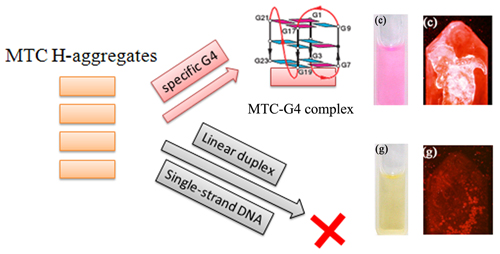Progress on the early detection method for tumorson the basis of cyanine dye supramolecular assembly
Nowadays, malignant tumor becomes one of the most serious diseases in the world. The development of highly sensitive diagnostic technology for early tumor is very important for its prevention and control. Among the various diagnosis strategies, targeting tumor-related DNA changes is one of the most direct and reliable detection method.
G-quadruplex is a kind of DNA secondary structure which contains guanine-rich residue. Its formation, denaturation and translation between different motifs involve in a series of tumor-related physiological processes. Funded by National Natural Science Foundation of China, Chinese Academy of Sciences, and Ministry of Science and Technology of China, researchers from State Key Lab for Structural Chemistry of Unstable and Stable Species, Institute of Chemistry, Chinese Academy of Sciences is committed to recognizing and labeling tumor-related DNA structure on the basis of cyanine dye supramolecular assembly over the years. Recently, the researchers made a series of progresses in recognizing specific DNA G-quadruplex structures (J. Phys. Chem. B., 2008, 112, 8783-8787; Chem. Comm., 2009, 1103-1105). Prof. Hans J. Lipps in University Witten-Herdecke and Prof. Daniela Rhodes in University of Cambridge had cited this achievement in their review (Trends in Cell Biology, 2009, 19(8), 414-422) as a new strategy “for the presence of G-quadruplexes at human telomeres was obtained using a highly fluorescent compound that is specific for G-quadruplex DNA structures” .
Meanwhile, the researchers also applied this strategy intophysiological condition and succeed in recognizing specific DNA G-quadruplex structures both in solution and on interface (Anal. Chem., 2010, DOI: 10.1021/ac1017716). On the basis of previous work, via molecular design, the high-specificity and high-sensitivity recognition of parallel/hybrid G-quadruplex have been achieved. This work have been published in Nucleic Acids Research (2010, 38, 1022-1033)(IF 7.479), which is one of the most influential journal in nucleic acid field.
This method provides a novel strategy on recognizing and labeling specific DNA motifs and could be expected to applied into tumor early warning and diagnosis. At present, researchers is collaborating with hospital to develop this method to clinical detection, and have made some progress.






